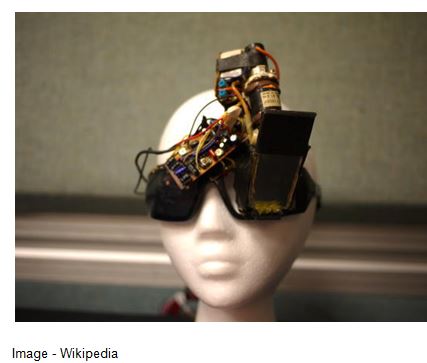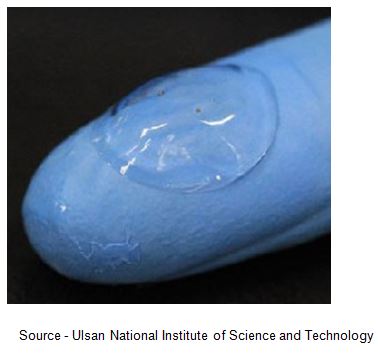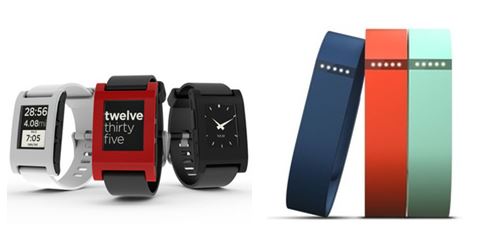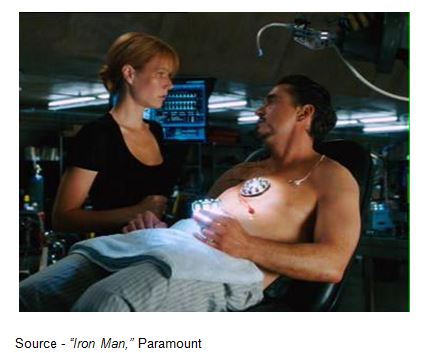 By Andy Marken
By Andy Marken
My mama said, "If you can't say anything nice about someone, don't say anything at all," so I won't say anything about Google Glass.
To its credit ... the stupid thing did raise the awareness of wearable technology and that's a good thing.
But, as Apple's Cook (who wears glasses) said, and we paraphrase, "elegant, sexy it ain't."
Wearables could be the stimulus smartphone and tablet folks need to keep sales climbing, since they have just about peaked as far as the number of people who use them are concerned.
Sure, there will be incremental growth; but it will be much slower and each new customer will be more expensive to obtain.
Most of the wearables we've seen tie into the higher-performance, higher-capacity devices and then ... the cloud.
But as Tony Stark commented, "I don't like it when you have plans."
So, if you don't have an iPhone or other smartphone and want the super cool wearable, you buy the phone/tablet, add the app and the device.
Actually, Glass isn't new.

Early Glass – Ever since Ben Franklin started wearing bifocals, tinkerers have been working on how to improve our ability to absorb more with our eyes. Even the "stigma" of four-eyes has gone away. Just can't say that your Glass makes you look any smarter.
People have been fiddling with the idea for years and they've come a long way with Google Glass; but for ordinary folks, really?
Don't get me wrong,
Glass and similar hands-free solutions will be ideal for a lot of applications where people need technical and specific information such as warehouse people, fire personnel, electricians and other careers you can add.
A Glass approach that "might" tempt me is the integration of a display into a contact lens that is worn directly on your eye.

Tapping the World – Technologists in South Korea could be on the right track in developing a wearable communications solution that keeps you in touch without being obtrusive. Less is often more.
The research on eye safe, flexible, transparent conductors was carried out by the Ulsan National Institute of Science and Technology in South Korea.
The lens would be soft, stable and have all the functions of a wearable computer.
The researchers, and their partner Samsung, are happy with early test results but it will be a few years before you can get yours.
The first few generations probably won't be cheap and won't have the appeal of Glass because no one can see you spent all that money on an eyeball computer.
But if I want to read my emails or search a website while I'm walking, talking, whatever, I'll do what I've always done ... pull out my smartphone and do it.

Just Checkin' – It's difficult to remember what we did before the smartphone and how we stayed connected in our business/personal lives. The devices often cause a lot of anxiety when we "disconnect"-- even for a few minutes.
Not only is it more versatile, it is exercise and lets people know how important communications and staying in touch is for me.
Looking around with a Glass or glasses, who knows?
Agent Phil Coulson noted, "I know. We're working on it."
Wearables have been around for a long time in terms of products that monitor/protect older folks and people with medical issues.
But the new wave that has the potential of being used by anyone/everyone is the health awareness units.
In combination they will deliver a whole new breed of wearable devices that are both stylish and functional.

Multiple Connections – While the number of devices talking with other devices could easily be 10 times our global population, we each do our share with multiple devices – computers, tablets, smartphones, wearables ... just in case.
While machine-to-machine (M2M) will account for most of the connected devices, we humans are going to make the best of the technology for ourselves ... and we're going to look stylish doing it.
The first are the healthcare monitoring, assistance wearables.
The second are the personal monitoring/improvement wearables.
Healthcare Wearables
Statistically the more countries spend on healthcare, the sicker the populations becomes.
The most pampered generations, Baby Boomers and beyond, may not live as long as their parents, they also seem to live in a less healthy state. People of all races and nationalities are seeing the quality of their life expectancies decline.
Wearable sensors are available for all sorts of health tracking, blood pressure, heart monitoring, steps walked, glucose levels and body weight.
The monitors already connect to smartphones and computers, where their data can be analyzed by individuals and caregivers.

Constant Care – A key component to controlling healthcare costs and improving individuals' lives is the ability to keep tabs on important conditions to get assistance before it is needed so that costs are controlled and quality of life is improved.
This provides immediate feedback on the individual's health and identifies deviations and problems at their early stages to let the individual, caregiver and healthcare practitioner take the appropriate action and eliminate/minimize costly and sometimes painful care.
The monitoring of the health conditions leads to major concerns over insurance/employer accessing the data and limiting or denying coverage or termination.
In addition, there are legal concerns over the individual's misinterpretation of the data as well as the FDA's (Federal Drug Administration's) ability to evaluate and approve the devices for personal healthcare usage.
These are issues that have to be addressed (along with the security of ultra-private healthcare information in the Cloud), according to leading healthcare professionals.
The Wireless Life Science Alliance found that in the U.S. alone, we waste over $210 billion in unneeded care, $190 billion annually in excessive administration, $130 billion in overpriced care and $75 billion in fraud.
Wearables can obviously reduce those costs and save lives.
Be Healthy, Stay Healthy
In line with the health issues, Pew Research recently reported that seven in 10 individuals in the U.S. track their health indicators:
60% of the adults say they track their weight, diet, or exercise routine.
33% track health indicators or symptoms, like blood pressure, blood sugar, headaches, or sleep patterns.
12% track health indicators or symptoms for a loved one.
Without the use of wearable devices, most of the tracking is informal:
49% of trackers say they keep track of progress "in their heads."
34% track the data on paper, like in a notebook or journal.
21% use some form of technology to track their health data, such as a spreadsheet, website, app or device.
Obviously, wearables will catch "everyone's" attention because they will help people reduce or avoid the major cultural illnesses we have – obesity and a sedentary lifestyle.
But Pepper Potts noted, "I don't think you could tie your shoes without me."

Wearable Ingredients – The wearable tech products that gain the greatest volume of sales won't be devices that let us stay in touch with someone else, but devices that let us stay in tune with ourselves. Wearable communications devices are nice, but they don't contribute to ... you.
Noted analyst Mary Meeker of KBCB (Kleiner Perkins Caufield & Byers) projects the healthy tools market will be big because they make individuals more aware of what they do, what they eat.
Whether it's an Apple iWatch, Sony SmartWatch, Nike FuelBand, Fitbit or Jawbone Up, thousands of monitoring/ tracking devices will be available by the end of the year (newer, better, sexier devices will be highlighted at CES).
Of course, when Apple releases its wearable things, they're not going to work with those "other" phones, so they'll sell more iPhones and the flip side of the coin will also be true.
Regardless of their OS loyalty, folks will snap them up and wear them with pride and panache to amaze friends, family, any bystander who will listen.

Wearable Variety – The avalanche of new/better wearable products will gain rapid acceptance and sales volumes. If we're real lucky, they may help people control themselves in a healthier manner (probably not). Early devices, like the Pebble smartwatch and FitBit Flex (above), are just a couple of the solutions that everyone is rushing to the market to meet your performance, style needs.
After all, who doesn't want to lose weight, be buff/healthy? And if buying a wearable and adding an app will do it, whoopee!!!
As Tony Stark said, "I'm prepared to lose a few with you."
Depending on the one you choose, they'll connect with your smartphone (iOS or Android) to monitor, track, log your exercise, sedentary inactivity, sleep (including quality of sleep), calorie intake, vital signs and more, producing a human cloud of personal data.
And we all know how private and secure personal data is in the cloud. But that won't matter because the wearables will look sleek, sexy and be elegant in design.
Most people who already wear/use them regularly say it's hard to remember if you're even wearing it.
They will be so much in demand that a lot of folks will buy one sight unseen/untried.
Others will buy two.
Folks with a real need to get/stay fit fast will get three or four or ...
It's really all about the apps and use, but you can be sure they will be with and on everyone in the years ahead.
Concerns
According to a recent study by the Centre for Creative and Social Technology, 59 percent of the respondents said wearable technology would help them feel more in control of their lives.
Of course, they won't be for everyone because people are already voicing their concerns about more data "they" can tap and use against us.
The same study noted that 53 percent wouldn't wear one because of privacy concerns and over 45 percent said the devices could lead to greater Big Brother involvement.
What's the Downside?
O.K., so there's a little concern about privacy and security but what's the real downside?
According to Deloitte's Center for Health Solutions:
- A lot will be sold but proactive use will be limited to improvement-oriented personalities
- Most will ignore the data (like weighing yourself daily, signing up for the gym, using a pedometer)
- Others will drop out because of unrealistic goals, low progress
A lot of the devices will be like the clothes rack treadmill in our home.
It would also be neat if they could motivate users to healthy actions like:
- Jolting your legs so you jump away from the table when you've had just enough to eat
- Cramping your hand as you reach for the door of the greasy fast-food place
- Setting off a siren before you eat the 5th piece of multi-cheese, multi-processed meat cheese
- Lighting up the arm as you start on the 2nd 6-pack of Coke or beer
- Kicking you out of the rocker to walk around the block
Yeah, there are probably laws against that sorta' stuff.
The technology is cool and beneficial. Now all we have to do is get people to buy/use them for style symbols because it's real hard to change personal behavior.

Looking at Tony's wearable, Pepper Potts observed, "I thought it'd be bigger..."
Even with technology, there's no silver bullet or rose-colored Glass!!



























































































